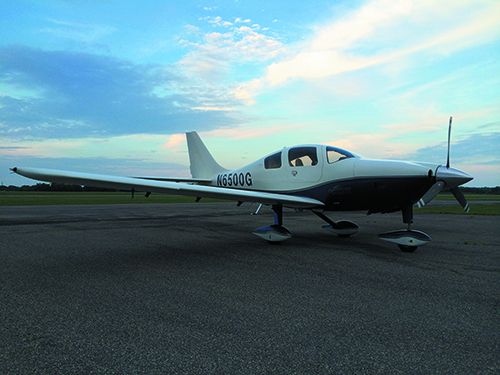Everyone knows that buying a used airplane involves a level of risk, and despite the requirements for record keeping and mandatory annual inspections any number of significant gremlins can hide within the airframe. The risk increases substantially with an aging composite structure.
Face it, while aluminum aircraft still dominate the fleet, composite construction represents a rapidly growing portion of the for-sale options. With the first London, Ontario-produced Diamond DA20s leaving the line in 1995 and the first Cirrus SR20 flying out of Duluth in 1999—hundreds, if not thousands, of used examples are options for buyers looking for the sleek appearance and other desirable characteristics embedded in these composite designs.
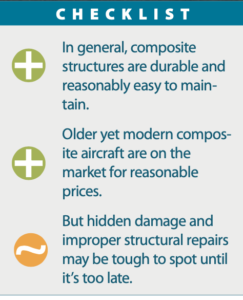
But as a potential buyer your questions should be: What lies beneath the glossy gel coat, is there hidden damage that will surface during the next annual inspection and after your check has cleared, and were all repairs done per the maintenance manual?
For this article we talked with shops, sales pros and aircraft manufacturers who weighed in with advice for shopping the used composite aircraft market and major items to look for during a prepurchase inspection.
VERSUS METAL
Notwithstanding deep problems like cracked spars and hidden corrosion, on a metal airframe identifying airframe issues is reasonably straightforward. Not so much with composites, which starts at the surface with critical paint considerations.
Coatings are a major component of a composite structure. Ultraviolet radiation, a significant part of what the star closest to our home planet emits, can quickly degrade the resins used in bonding the various components that make up a composite part. Some resins also respond poorly to heat.
“You’ve seen lots of aluminum airplanes where the paint is just faded away or not even present,” Chris Eichman, an owner of Cirrus sales specialist Aerista, said. As Eichman pointed out, what is acceptable and airworthy on the surface of a Bonanza isn’t really the case on composite plane. The paint has to be in good condition in order to provide the UV protection properties.
Eichman went on to add that there are restrictions on how one can apply paint and other finishes. Cirrus and the other manufacturers of composite planes have specific rules about the paint product itself, about the colors and about the placement of colors on the airplane.
“There is a reason you’ve never seen a black Cirrus—in fact, there is a reason you’ve never seen a Cirrus with black stripes above the bottom of the windows,” he said.
But some models on the market sport new and modern paint work that they didn’t have when they rolled off the assembly line, and they deserve a closer look. Early on, Cirrus buyers could order their airplanes in any color they wanted, as long as it was white. That’s because of an FAA-imposed limitation for fear that darker colors would absorb more heat and more quickly deteriorate the composite structure. But as time went on, darker colors were allowed, and the aftermarket followed with its own paint work.
Aerista has encountered composite airplanes for sale coated with the wrong paint or with paint schemes violating the manufacturer’s specifications on color or color placement. The only acceptable mitigation for a craft in that condition, likely at great expense, is complete removal of the paint and application of a conforming finish.
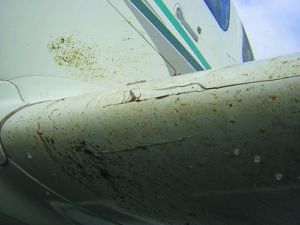
Resins in areas of a composite plane exposed to the sun due to eroded or missing paint will dry out and cause a delamination (more on delamination later). Repair of such damage is straightforward, but does come at a cost. One idiosyncrasy of at least some composite models is cracks in the paint.
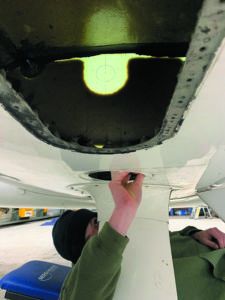
“People will often assume that means there is a crack in the underlying structure,” Eichman said. “A crack in the composite is something that can be tested for very easily. I can’t think of a time when we’ve seen a crack that has been anything other than cosmetic.”
IMPROPER REPAIRS
The FAA conducted a case study of five improperly done composite repairs. Granted the repairs were for commercial airliner parts, but the issues aren’t much different for GA aircraft. The study found instances of FAA repair stations using the wrong materials, not using the proper tooling, not following the manufacturer’s instructions for assembly, exceeding repair size limits and even using procedures specified for an entirely different aircraft. The result was always an unairworthy part that may not look any different from a properly repaired one.
Andrew Moonilal, a technical support specialist at Diamond Aircraft’s London, Ontario, plant, said Diamond finds things that were (or weren’t) done to its aircraft that deviate from what it considers to be an approved status. “We have worked backward to remove repairs and recertify the airplane back to our standards,” he said of these so-called repairs.
Darryl Taylor, general manager of Air Power Inc. and a noted expert on Cessna Corvalis and its predecessor Columbia models, gets concerned when an aircraft’s logs indicate major repairs that happened without the involvement of the aircraft’s manufacturer.
Taylor told us that every now and then he sees major repairs that were signed off on an FAA Form 337 (which in the eyes of the FAA is indeed a major repair and/or alteration) by a local designated engineering representative (DER). According to him, buyers might stay away from these planes just because support from Textron Cessna is questionable, and that greatly reduces the aircraft’s value. On the other hand, we’ve seen some structural repairs (signed off by a DER) that were as good as what the OEM turned out. The key is good documentation of the work, and a good inspection to vouch for it.
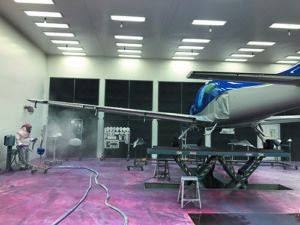
Speaking of good documentation, that’s what often happens at Diamond. When notified of an event causing significant damage to one of its airplanes, Diamond’s technical support and engineering organizations develop a Repair Design Approval (RDA). The RDA is an explicit set of specifications, instructions and procedures for returning the airplane back to an airworthy condition. It also becomes a permanent part of the aircraft’s history.
Moonilal at Diamond said its repairs are meant to be done in the field without any special equipment, and a lot of composite repairs use a combination of heat and vacuum bagging, which is what is done in the manufacturing process.
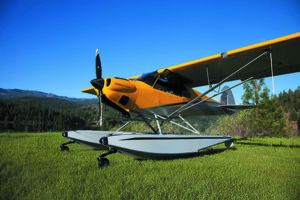
“But when we engineer a repair, it’s such that there is no need for vacuum bagging in probably 99 percent of the cases. You just lay up the layers of glass, foam or carbon and apply heat at a certain temperature to cure the resins,” he said.
DELAMINATION
Composite structures are just that. They are composed of different materials bonded together with resins, usually in layers. Any component of the composite “sandwich” can separate from an adjacent layer, creating a void and a subsequent structural problem. This is delamination, or in some cases, debonding.
The basic test for delamination is remarkably simple. A technician taps the structure with a coin or other small metal instrument and listens for differences in the sound the tap produces. A duller returned sound may indicate the presence of delamination and indicate a need for repair. More advanced non-destructive testing techniques, like ultrasound inspection, can confirm the presence and extent of the damage.
Diamond’s Moonilal pointed out that any airplane in their certified pre-owned program gets a complete nose-to-tail, wingtip-to-wingtip examination, and delamination is high on the list of the things to look for.
“One of the things we cover with the MSI (major structural inspection) is a tap test,” adding that it includes tapping the entire airframe—looking and listening for delamination between the layers of glass or carbon. If Diamond suspects something isn’t quite right, it will remove the paint and primer from that area and inspect the composite structure by any means necessary.
MSI is a recurring requirement for many of Diamond’s aircraft. For example, the DA40 requires an MSI after 2000 hours of service and one every 2000 hours after that. The DA62 twin requires its first MSI after 6000 hours with repetition at subsequent 4000-hour intervals.
Cessna has a similar recurring requirement at 3000-hour intervals. “There are a few airplanes out there that are over the 3000-hour mark, and although we have never done one at Air Power, my best guesstimate is that it is going to add about 25 hours to the annual inspection that particular year, plus discrepancies,” Taylor said.
What may be more important is how a delamination occurred. The case of issues created by poorly maintained paint mentioned earlier are relatively straightforward and easily repaired. Other causes may create a larger concern.
“Typically, delamination is a sign of unusual loading of the composite structure. Unusual bending usually causes delamination or debonding of parts of airplanes,” Moonilal said.
Obviously, a delamination issue, possibly caused by abnormal loading, is reason for further examination and understanding. While the damage is likely repairable—particularly if there are no visible deformities in the structure—what sort of regular service or unusual incident caused the problem in the first place? The recent NTSB report on a fatal Embry-Riddle Aeronautical University Piper Arrow crash confirms that an unusual service life (like training) can impact an airframe in unexpected ways. Plenty of used-market composite models have lived hard lives on training lines.
LIFE LIMITS

Most general aviation aluminum airframes’ type certificates do not carry either an age-related or service-related life limit. There are exceptions, but if owners maintain the craft in a fashion consistent with the manufacturer’s specifications, and manage and attend to any corrosion, the basic airframe should last forever.
Things are different for the composite designs. Their type certificates include specific lifetime limits and/or required major inspections.
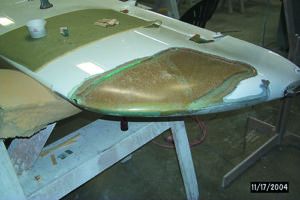
Cirrus is seemingly the most restrictive with an airframe life limit of 12,000 hours. With the first airplanes introduced in 1999, it is possible for airplanes, particularly ones that served as trainers or in other fleet situations, to be approaching that magic number. An individual owner flying about 100 hours a year is not going to add time up to those sorts of hours very quickly, but the limit is a purchase consideration.
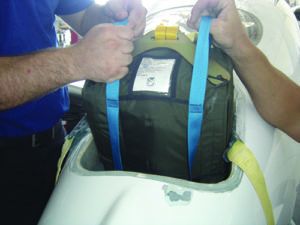
A web post from Cirrus’ engineering organization says as the fleet begins to approach that number, a combination of further testing, analysis and inspection may extend the 12,000-hour figure.
Textron Cessna’s limit on the Corvalis (formerly Columbia) models is 25,200 hours, more than double the Cirrus value. As Darryl Taylor pointed out, no aircraft in the fleet has amassed anywhere near that amount of time, but as mentioned the airplane does require the 3000-hour inspection.
Diamond’s type certificates, like most type certificates for aluminum airplanes, do not specify an airframe life limit. However, like the Corvalis, major inspections at defined intervals are part of required maintenance.
FRANKENSTEIN AIRPLANES
The FARs allow for the repair of virtually any aircraft, from parts in any condition. If an A&P follows the rules, takes care of the paperwork and an IA signs everything off, the regulations deem the aircraft airworthy. Often components of several airframes combine to make an airplane that may or may not be all that it seems, or all it is represented to be.
The good news in that the manufacturers maintain lists of airframe serial numbers they believe have sustained damage beyond what they considered to be repairable. In other words, ones you don’t want at any cost.
“There are serial numbers that are not supported by the factory for a variety of reasons,” Eichman said. “That includes planes that have been destroyed in a crash, but there also are planes out there that have been crashed, damaged and put back together in a Frankenstein way.”
A call to the factory line prior to a purchase can ensure that it still fully supports the prospective serial number.
It is interesting that parachute deployments on Cirrus airplanes do not necessarily land them on the list. “There are plenty of parachute-deployed airplanes that have been legitimately repaired and are back in service and fully supported by Cirrus,” Eichman said.
On the topic of whole-airplane parachutes, it’s worth mentioning that first-generation Cirrus models require substantial composite and paint work during the required 10-year repack. That’s because accessing the CAPS means breaking the fiberglass in the upper area of the fuselage, aft of the rear window. We covered the entire costly process in a field report back in the December 2012 issue of Aviation Consumer.
Undeniably, a distinct advantage for any purchaser of a pre-owned composite plane is that they all are relatively young, at least compared to the average age of the aluminum airplane fleet. In many cases these airplanes have relatively few hours of total time and are still in factory paint, and many are stored in climate-controlled hangars. Plus there simply has been less time for something bad to have happened to them.

Another obvious advantage is that corrosion is essentially unheard of in a composite airframe. Sure, some non-composite accessories will corrode, but it just isn’t the major concern for a buyer compared to shopping for, say, a Comanche or vintage Bonanza, to name two all-metal machines.
As Cirrus pro Chris Eichman pointed out, the control surfaces on an SR20 and SR22 are aluminum and little stuff like boarding steps and handles and things like that can corrode, but typically those things are not structural. All of the plane’s structure is composite and therefore can’t corrode.
Ultimately the biggest issues with a composite airplane purchase will exist forward of the firewall, just like it is with any other airplane. That is where the costly parts and repairs reside. But the potential does exist for problems in the airframe and those problems are different. However, with the right advice and inspection, a pre-owned composite aircraft could make for a satisfying ownership experience. They’re strong, they look modern and most have favorable resale values compared to some metal airplanes.
EXPERTS MATTER
Involving the right expertise in the buying process for a pre-owned composite airplane is incredibly important, but unfortunately it doesn’t always happen.
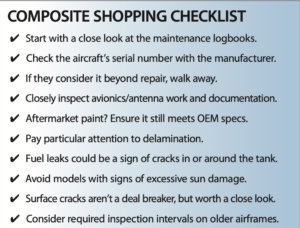
“I’m a big fan of expertise,” Air Power’s Darryl Taylor said, making the good point that a particular A&P/IA or repair station cannot be an expert in all piston single- and twin-engine airplanes—metal or composite. But as for composites in particular, there are a handful of shops that just know these airplanes inside and out, and of course that generally includes factory authorized service centers. They have access to the approved parts network, service bulletins, service manuals, training and support from the factory.
That’s why it’s not uncommon for aircraft that have been cared for by these shops their entire life (with logbook entries as proof) to carry a price premium. But that still doesn’t mean the prepurchase evaluation should be shortchanged.
Taylor went on to say that he does not think twice about damage repaired by a shop he knows to be skilled in the Corvalis/Columbia line. Work done by other shops may be safe and airworthy, but his shop has seen issues when conducting an annual or other service on those planes.
It’s one of many reasons why you simply need to have the airplane inspected by a shop that’s skilled with both composite repairs and maintaining the model you’re ready to call your own.

